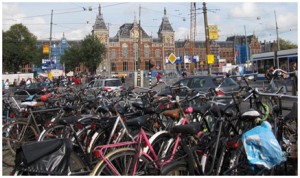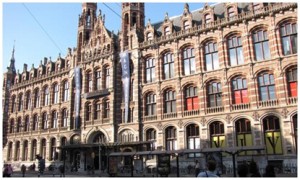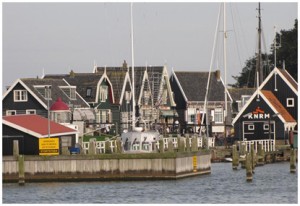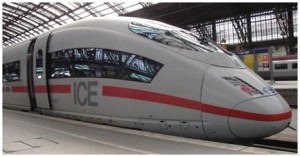Premlata Venkataraman
e-mail:Â ThePatrika@aol.com
Holland is a good example of humans adapting to the environmental constraints imposed by Nature, instead of designing a lifestyle by overpowering it with all bad consequences. About 30% of the land mass is below sea level, and 10% of its land along the coast is reclaimed from the North Sea. Historically, the country was prone to perennial flooding, making farming a perilous activity. However, by digging canals — some of them only a few feet wide and interconnecting them to larger ones — and building dykes, they pump the water back into the sea. Amsterdam, situated only two meters above sea level, is as flat as a pancake, a city that beautifully interweaves water and land.
The canals, used primarily to divert water from land into the sea, also provide an efficient and scenic way to traverse the city. Gliding along the waters, one can see many 17th century buildings – some magnificent, and many cute — still pristine in condition. Ongoing restoration projects, many of them publicly funded, preserve the old buildings like new.
A popular mode of transportation around Amsterdam seems to be the bicycle. Outside the Centraal train station there are hundreds upon hundreds of bikes chained to posts in marked parking areas, or in a three-story bikes-only parking garage. Roads have well marked bike lanes and bicyclists abide by signal lights for their lanes.
The unique architecture of the buildings also sported some unique designs. Grand entrances through massive doors lead into the house. Meanwhile small doors just below the floor level were, in olden times, for use by the servants. Also, historically the tax for the house was calculated according to the width of the house on the street. Consequently, there were some ridiculously narrow houses stuck in between bigger ones, with narrow, steep stairs. So, all buildings have hooks on the top on the outside to haul household goods to upper floors.
This was apparent on a visit to Anne Frank’s house, one of Amsterdam’s famous residents. Her account of the Holocaust, chronicled in her diary makes vivid the agony suffered by millions of Jews. Her family lived hidden in one of the attics behind a bookcase. In a guided tour, climbing through those steep narrow stairs up to an airless attic brought alive to the visitor to glimpse her suffering.
Driving away from the city gave way to scenic farms with dairy cows and sheep grazing — cheese making is big business here. The ancient fishing village of Volandam provided a snapshot of life here centuries ago. Men dressed in loose black trousers with bowties and women in long dresses with intricately laced aprons strolled along the streets. Their homes clustered within narrow pathways and narrow canals to drain the water, and walking through them you experienced the close-knit community. Many homes used to be on stilts to avoid flooding. Since the canals and dykes have eliminated this problem, owners have built walls around the stilts, adding more living space.
Next, we took a train to Rotterdam. Railway stations and riding trains are pure nostalgia to us who used to take long train journeys to reach our ancestral villages in India. Even entering the cavernous station evokes pleasant memories. Everything from purchasing our tickets to getting to the platform was easy and efficient. Platforms were spotless and signage made maneuvering easy, as in airports. Inside our rail car, monitors kept us informed how fast the train was moving and when the next station was scheduled to arrive. Sitting on comfortable seats with spacious luggage racks made for a very pleasant journey.
Rotterdam, one of the largest seaports in the world, is a huge fully automated shipping center, transporting goods from many parts of the world to Northern Europe. Even the Rotterdam railway station was huge and intimidating. Our destination was Brielle, pronounced Brie-luh as our Afghani taxi driver informed us. The main roadway had exits for harbor numbers through 9999!!! We also passed through a huge Shell refinery where crude oil from the Middle East and North Sea is processed and stored in huge containers. These containers stretched for a few mile on the roadway. We also saw dedicated trains carting cars from Korea and Japan to temporarily place them in large garages.
After an hour we were in the small town of Brielle. A very small city with a prominent historic past, it had a little something for all visitors. A huge cathedral over powered the city, beautiful canals, old-fashioned windmills, small winding streets paved with cobblestones and several boutique restaurants. By sunset the streets were empty and kids plied their bikes on the Main Street!
The Brielle Cathedral, an imposing structure established in 13th century, was in excellent condition. The cathedral had beautiful stained glass windows and the pews were old polished hardwood. Many famous people were entombed there and there was a commemoration of the wedding of William of Orange to Charlotte Bourbon. The walks along the canal were endless and benches placed along them to rest and admire the picture perfect scenery.
Near Brielle we drove through an area currently being reclaimed from the sea. The work has been going on for the last several years. It was surreal to stand on new reclaimed ground and watch massive pipes bringing in a slurry of sand and gravel from the ocean floor far away and pumping it onto the land to make new land available.
Historically, though Holland was a small country, its ships ruled the waters, and they are the first one to harness wind energy on a large scale. In modern times, Holland with large area at or below sea level, uses technology to manage water seepage sensibly. Holland is a good example to the rest of the world on how to use modern technology to live with nature without trying to overpower it.    ♦






